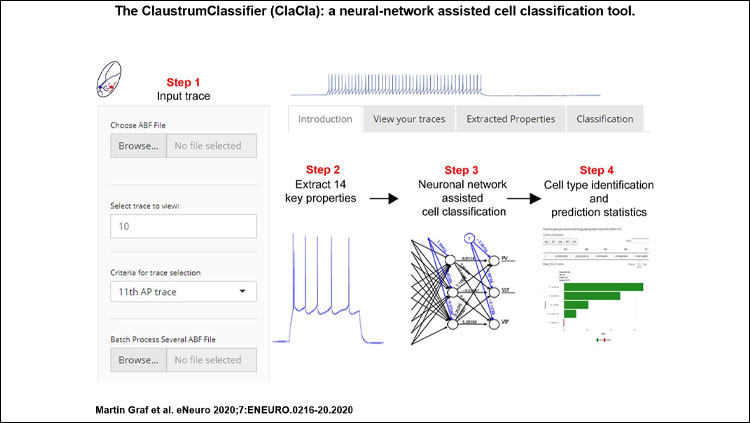 |
|
|
Material below summarizes the article Identification of Mouse Claustral Neuron Types Based on Their Intrinsic Electrical Properties, published on June 11, 2020, in eNeuro and authored by Martin Graf, Aditya Nair, Kelly L.L. Wong, Yanxia Tang and George J. Augustine.
Highlights
- Claustral neurons consist of at least three types of inhibitory interneurons and five types of excitatory projection neurons.
- Claustral neurons that project to different brain areas differ in their electrical properties.
- A user-friendly tool allows you to use our classification scheme to identify neurons in your own cell recordings.
Study Question
The claustrum is a relatively small structure, yet it connects to almost the entire cortex. While the exact function of the claustrum remains a mystery, it has been shown to be involved in multiple higher cognitive functions.
To better understand claustral signal processing, it is important to identify the types of neurons that exist within the claustrum. While previous work has described a few different cell types, these studies lacked a systematic and comprehensive way of characterizing claustral cell types.
The goal of this study was to close this gap and provide a detailed, yet user-friendly, way to classify claustral neurons purely based on their intrinsic electrical characteristics.
Experimental Design or Methodology
To measure the intrinsic electric properties of claustral neurons, mouse brains were sectioned and individual responses of claustral neurons during electrical stimulation were measured via an electrode (whole-cell patch clamp recording).
The intrinsic properties of 326 neurons were compared and unsupervised clustering of these properties was used to group neurons into different types. To validate the clustering results, we also asked whether the cell type correlated with marker gene expression (for interneurons, INs) or their anatomical connections to downstream brain regions (for projection neurons, PNs). In addition, individual neurons were grouped into identical cell clusters by using two alternative methods for the visualization of multidimensional data (t-distributed Stochastic Neighbor Embedding and Locally Linear Embedding).
Finally, machine learning was used to automatically extract cell properties and identify the cell type according to our classification scheme.
Results
First, the electrical properties of all claustrum neurons were compared and allowed the neurons to be separated into two main groups. Both groups differed in nearly all of their intrinsic properties. Besides these differences, both groups differed in their anatomical projections to other brain areas and the expression of various IN markers, establishing these groups as either INs or excitatory PNs.
Next, both main groups were analysed separately, to identify subtypes of PNs and INs.
PNs were optimally grouped into five subtypes, based on subtle differences among their intrinsic electrical properties. PN subtypes differed in their projection targets: one type of PN targeted subcortical areas, while the remaining four targeted the cortex.
INs could be clustered into three main groups that correlated well with the expression of three IN markers parvalbumin (PV), somatostatin (SST), and vasoactive-intestinal peptide (VIP). PV neurons were most distinct within the IN groups and separated well from VIP and SST neurons, while the latter two groups showed some degree of overlap. Alternative clustering approaches confirmed these results and showed that distinct IN subtypes were characterized by IN subtype specific intrinsic properties.
Finally, we automated cell property extraction and subsequent classification of claustral neurons. Our software provides a user-friendly way to classify claustral neurons and offers a basis for a standardized classification of claustral neurons across different labs. The software is open source and can be used as a web-based application or can be downloaded from GitHub.
Interpretation
This work provides a reliable and robust classification scheme to identify three IN and five PN subtypes in the claustrum. Our work extends previous studies in two ways: it characterizes previously unstudied IN subtypes and provides evidence that claustral PN subtypes not only target cortical but also subcortical areas. The classifier software we wrote allows for hassle-free identification of those cell types and creates a standardized classification scheme for all labs in the field.
This work is foundational because it identifies the different neural components within the claustrum network. Thus, it will advance our understanding of signal processing within the claustrum by providing a key to identify distinct claustral cell types and eventually help us to understand how the claustrum contributes to higher-order brain functions.
Visit eNeuro to read the original article and explore other content. Read other summaries of eNeuro and JNeurosci papers in the Neuronline collection SfN Journals: Research Article Summaries.
Identification of Mouse Claustral Neuron Types Based on Their Intrinsic Electrical Properties. Martin Graf, Aditya Nair, Kelly L.L. Wong, Yanxia Tang, and George J. Augustine. eNeuro 11 June 2020, 7 (4) 0216-20.2020; DOI: 10.1523/ENEURO.0216-20.2020.









